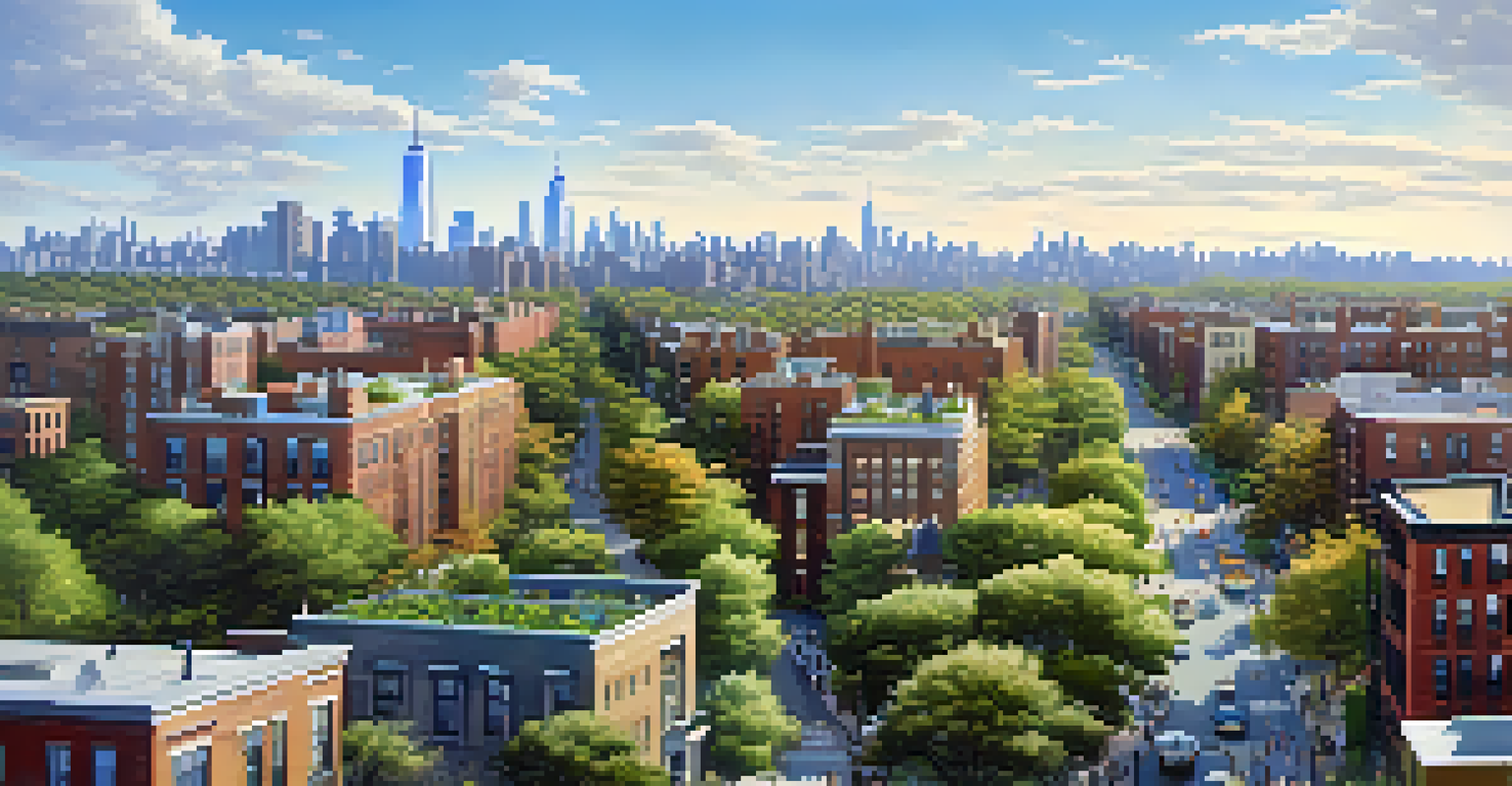The Role of Density in NYC's Urban Development Strategy

Understanding Urban Density in New York City
Urban density refers to the number of people living in a given area. In New York City, density plays a crucial role in shaping neighborhoods, infrastructure, and community dynamics. The city's iconic skyline is a testament to how vertical living accommodates a growing population while preserving open space.
Cities are the greatest creations of humanity, but they are also complex, fragile ecosystems that require careful management and planning.
New York City is one of the most densely populated urban areas in the United States, with over 27,000 residents per square mile in some neighborhoods. This high density encourages the use of public transportation and promotes walkability, making it easier for residents to access amenities and services. It also fosters a vibrant street life, where diverse cultures and ideas converge.
However, this density also presents challenges, such as overcrowding and strain on public resources. Balancing the benefits and drawbacks of urban density is essential for sustainable development. Understanding these dynamics is key to NYC's ongoing urban development strategy.
The Historical Context of NYC's Urban Density
New York City's urban development has been influenced by various historical factors, including immigration and economic growth. The city's rapid population increase in the late 19th and early 20th centuries necessitated vertical expansion, leading to the construction of high-rise buildings. This trend established a unique architectural landscape that characterizes NYC today.

Additionally, zoning laws and policies have shaped how density is managed. For example, the 1916 Zoning Resolution aimed to regulate building heights and protect light and air access for residents. These regulations have evolved, reflecting the city’s changing priorities and the need for sustainable urban growth.
Urban Density Shapes NYC Life
Urban density in New York City influences neighborhood dynamics, public transportation use, and vibrant street life.
Understanding this historical context helps us appreciate the complexities of density in NYC. It also underscores the importance of adapting past lessons to meet current challenges in urban planning and development.
Density and Its Economic Implications
Density has significant economic impacts, influencing property values, business opportunities, and job creation. In densely populated areas, businesses benefit from a larger customer base and increased foot traffic, which can lead to higher revenues. This economic vitality is a driving force behind NYC's continued growth and development.
The best way to predict the future is to create it.
Moreover, densely populated neighborhoods often attract diverse industries, from tech startups to creative agencies. This concentration of businesses fosters innovation and collaboration, making NYC a global hub for entrepreneurship. The economic benefits of density contribute to the city's reputation as a desirable place to live and work.
However, the rising costs associated with urban density can lead to gentrification, pushing out long-term residents. Balancing economic growth with affordable housing is a pressing concern for city planners, as they strive to create inclusive communities.
The Environmental Impact of Urban Density
Urban density also plays a crucial role in environmental sustainability. Higher density can lead to reduced per capita energy consumption and lower greenhouse gas emissions. When more people live near their workplaces and essential services, it decreases the reliance on cars, promoting public transportation and reducing traffic congestion.
Furthermore, dense urban areas can support green initiatives, such as community gardens and rooftop parks, which enhance biodiversity and improve air quality. These green spaces provide essential ecological benefits while also offering residents places to relax and connect with nature.
Economic Impact of Density
High urban density drives economic growth by attracting businesses and fostering innovation, but it also raises concerns about gentrification.
However, managing environmental impacts requires careful planning and investment. City officials must prioritize sustainable practices in urban development to ensure that the growth of density does not come at the expense of the environment.
Community Engagement in Urban Density Planning
Community engagement is vital in shaping urban density strategies. Local residents often have unique insights and concerns that can inform decision-making processes. By involving communities in planning discussions, city officials can foster a sense of ownership and responsibility towards their neighborhoods.
Public forums, surveys, and workshops are effective ways to gather feedback and ideas from residents. This collaborative approach helps ensure that development projects align with the needs and desires of the community, promoting harmony between density and livability.
Ultimately, successful urban density planning requires balancing the interests of various stakeholders, including residents, businesses, and city officials. Engaging the community is essential to achieving sustainable and equitable urban growth.
The Role of Technology in Managing Density
Technology is transforming how cities manage density and urban planning. Smart city initiatives leverage data analytics and digital tools to optimize resource allocation and improve infrastructure efficiency. For instance, real-time data on public transportation usage can help city planners make informed decisions about service improvements.
Additionally, technology enhances communication between city officials and residents. Mobile apps and online platforms allow citizens to report issues, provide feedback on development projects, and stay informed about urban initiatives. This transparency fosters trust and encourages greater participation in the planning process.
Sustainable Density Planning Needed
To manage urban density effectively, NYC must prioritize community engagement and sustainable practices in its development strategies.
As technology continues to evolve, its role in managing density will likely expand. Embracing innovative solutions can help NYC address the challenges of urban growth while enhancing the quality of life for its residents.
Future Trends in NYC's Urban Density Development
Looking ahead, several trends are shaping the future of urban density in New York City. One significant trend is the focus on mixed-use developments, which combine residential, commercial, and recreational spaces to create vibrant neighborhoods. This approach promotes walkability and fosters a sense of community, making urban living more appealing.
Another trend is the emphasis on sustainability and green building practices. As climate change becomes a more pressing concern, developers and city planners are prioritizing eco-friendly materials and energy-efficient designs. These practices not only reduce the environmental impact but also improve the long-term viability of urban areas.

Ultimately, the future of NYC's urban density will hinge on how well the city adapts to changing demographics, economic shifts, and environmental challenges. By embracing innovative strategies and sustainable practices, New York City can continue to thrive as a dynamic urban center.